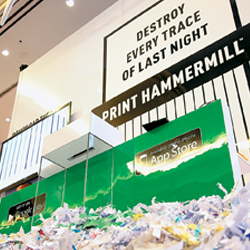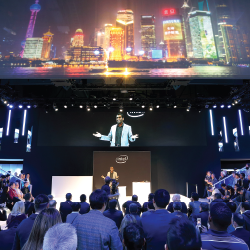
hen Salvador Dali said, "Have no fear of perfection – you'll never reach it," the famous Spanish artist didn't add, "So don't even try." In fact, one could argue that he was encouraging people to venture outside their comfort zones and push themselves to reach new heights. After all, the flamboyant mustachioed man painted melting pocket watches in a desert during a time when keeping it real was de rigueur in the art world.
So while perfection may indeed be unattainable, as Dali believed, improvement certainly isn't, especially when it comes to exhibit marketing. And it was that quest for continuing improvement that led Philips Home Healthcare Solutions to analyze its exhibit program and look for ways to perfect it.
The company, which makes home health-care equipment such as continuous-positive air pressure (CPAP) machines, had a successful track record at shows and consistently accomplished its objectives. But Philips wasn't doing anything out of the ordinary in terms of strategy or tactics, and it used a version of the same semi-enclosed booth property at each of the dozen or so shows in which it exhibited annually.

The attendee experience, while efficient, left room for improvement. Philips staffers and sales reps would greet attendees that wandered into the booth, help them peruse several sleep-apnea masks in its lineup, scan their badges, ask a few lead-qualification questions, and send them on their way. "Historically, Philips exhibited in the same way other companies
did at home health-care shows," says Karen DiThomas, special events manager at Philips.
"It displayed products on shelves but provided little opportunity for attendee interaction."
However lackluster it might seem, the process was paired with Philips' interest-piquing products, and it managed to net an acceptable lead figure that aligned with the company's previous goals. But Philips' exhibit team – and senior management – felt the company could do better.
With a mandate from upper management to increase the number of qualified leads generated, the percentage of high-quality leads, and the number of hands-on demos that took place in the booth in 2013, Philips enlisted the help of its exhibit house and an experiential-marketing company based in Chicago. It sought to make the most of its current exhibiting spend, and wanted to find a way to fine tune its already successful program so it could somehow generate even more leads and attention on the trade show floor.
In 2012, the Philips exhibit experience was all about physical structures such as towering walls and enclosed spaces. "It wasn't the most welcoming environment to casual passersby," DiThomas says. Staffers relied on attendees' interest in the products to draw them in, which meant most of the exhibit traffic comprised current customers who already knew what Philips was all about, knew who they wanted to talk to in the booth, and weren't deterred by the closed-off space. Product displays fea-tured little more than attractive shelves and counters featuring plastic mannequin heads wearing Philips' CPAP masks. It was functional, to be sure, but it wasn't exactly earth shattering. To remedy the situation and appeal to a wider attendee base, Philips decided it needed to incorporate more interaction and activity, and to make that visible to attendees walking the aisles. So down came the walls, and up went the engagement.
 Up Close and Personal
Up Close and Personal
Featuring a central reception desk surrounded by several modular product stations (the number varied depending on the show) and zero walls, the restructured exhibit was much more conducive to the type of interaction that Philips needed. Plus, by decreasing the number of graphics panels and eliminating all of the exterior walls, Philips reduced shipping and drayage costs. The exhibit team identified key areas within the new space best suited for hands-on interaction, including a mask-fitting station, a guessing-game activity, and experiential product demos via iPads.
But live interaction is nothing without, well, live people. Rather than spend the time and resources to school its existing booth staff – most of whom would not be too keen on additional training – on the nuances of attendee engagement, Philips decided to hire professionals it dubbed "docents." The docents would serve as the first touchpoint attendees encountered. They would also staff the interaction areas, help qualify visitors, and hand off attendees to the appropriate sales reps when the time came for more in-depth conversations.
The addition of docents meant sales reps could spend less time vetting every person that entered the booth and more one-on-one time with qualified leads that had proven purchasing power. This would prove crucial to generating the number of high-quality leads that Philips wanted. As an added bonus, hiring docents meant DiThomas could send up to 20 percent fewer Philips staffers to each show, thus reducing travel and accommodations costs for its own staff and keeping more reps out in the field. Next came the true test: executing the planned changes at Philips' trade shows.
Going Live
When attendees arrived at a Philips exhibit, docents armed with iPads and wearing branded aprons, cardigans, or scrubs in cheery hues such as cobalt blue and lemon yellow greeted them. After inviting visitors to check out Philips' offerings, docents escorted interested attendees to the mask-fitting station and scanned their badges. Featuring two to four CPAP machines and masks depending on the show, the station looked more like something you'd find in a spa than at a health-care show. Equipped with a white leather salon chair opposite a sleek white counter, and featuring mannequin heads fitted with masks and lit from within, the station presented the perfect opportunity for interaction.


Once an attendee sat down, the docent asked questions about the type of mask (e.g., the Wisp, Amara, Nuance, etc.) he or she wanted to try, and simultaneously entered qualifying
info into a lead-capture app on an iPad. "It was important for us to physically show attendees that we have what they want, and the best way to do that is to let them try on the masks and see for themselves," DiThomas says. As they chatted about the masks, the docent ensured a proper fit, all the while relaying key messages.

In addition to the mask-fitting station, some of Philips' exhibits – such as the one used at the 2013 Associated Professional Sleep Societies' Sleep show – also featured a semi-enclosed tunnel structure called the Allies Arch onto which iPads were mounted. Guided by docents, attendees stepped up to one of six iPads and slipped on headphones before embarking on an interactive experience featuring all of Philips Home Healthcare solutions, such as portable testing, masks, and the SleepMapper (a self-monitoring, Web-based program that tracks sleep-therapy compliance). All of the info was presented from the point of view of a newly diagnosed patient.
Other opportunities for engagement (introduced at various shows throughout the year) included a game wherein docents invited attendees to guess the amount of oxygen the Philips UltraFill home oxygen system cylinders can hold, and a demonstration to prove the durability of its SimplyGo portable oxygen concentrators. For that task, attendees watched as docents dropped the containers on the floor.
While attendees were learning about Philips' products, docents were filtering out the tire kickers from the high-quality leads by nonchalantly asking questions about facility size, current sleep/therapy solutions provided, patient types treated, etc. The answers were then entered into lead forms on docents' iPads. And though everyone was welcome to participate in the activities, only serious prospects were passed along to sales reps.
After docents handed off attendees to the sales reps, they started the whole process over again with a new crop of booth visitors. The result was a constant stream of high-qualified leads for Philips' sales staff.
Breathing Easy
After Philips rolled out the so-called "live approach" at eight trade shows in 2013, it was clear the interactive strategy worked. In a year-to-year comparison, the leads generated at each show jumped by double- and triple-digit percentage points. Though the average increase from 2012 to 2013 was 130.5 percent, there was an impressive outlier: The European Respiratory Society Annual Congress in Barcelona, where the number of high-quality leads gathered increased by a whopping 239 percent. At the same show, CPAP mask fittings increased by an almost unreal 4,900 percent in the first two days of the four-day show.
DiThomas credits the hands-on approach for the exhibit's success. "Interaction is key to helping qualify attendees and establish a connection with them," she says. "We brought in-booth conversations to a higher level and took the time to learn about what our clients and prospects really wanted to know. That type of engagement is hard to come by at the shows we go to, and Philips has now become a destination on the show floor."
Indeed, by shifting its exhibiting focus from static product displays to lively, interactive attendee experiences led by professional docents, Philips resuscitated a trade show program that had been simply meeting expectations. Now that's a breath of fresh air.





 hen Salvador Dali said, "Have no fear of perfection – you'll never reach it," the famous Spanish artist didn't add, "So don't even try." In fact, one could argue that he was encouraging people to venture outside their comfort zones and push themselves to reach new heights. After all, the flamboyant mustachioed man painted melting pocket watches in a desert during a time when keeping it real was de rigueur in the art world.
hen Salvador Dali said, "Have no fear of perfection – you'll never reach it," the famous Spanish artist didn't add, "So don't even try." In fact, one could argue that he was encouraging people to venture outside their comfort zones and push themselves to reach new heights. After all, the flamboyant mustachioed man painted melting pocket watches in a desert during a time when keeping it real was de rigueur in the art world. 
 Up Close and Personal
Up Close and Personal





